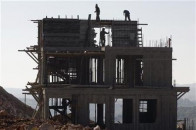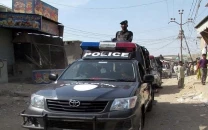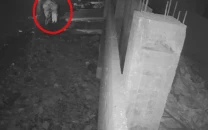Flood ‘14: Tori Bund level raised by two feet as residents fear water will overflow
Authorities expect medium-level floods to pass through bund that created havoc in 2010.

Even though only medium-level floods were expected to hit Sindh, the residents of Ghouspur and the adjoining villages in Tori feared the new bund was not high enough to prevent the water from overflowing.
"Look, the water level is rising," pointed out Haji Muhammad Sabzoi during a visit to Tori Bund on Tuesday evening, a day before the floods were expected to hit.
"They have made a new Tori Bund but its level is hardly seven feet above the river," he said, fearing that the entire area will be washed away again whenever the waters gushing down from the Punjab arrive.

Sabzoi's village, located on the right bank of River Indus, was the first settlement that was hit by the floods in 2010. The then Tori Bund had been washed away leading to massive destruction in the area.
The residents of other villages in Ghouspur town also share the same fears even though authorities are adamant that flood levels will not exceed 500,000 cusecs.
The local landlords approached the elected representatives in the area and now the irrigation department has been tasked to allay these fears. A few bund engineers are raising the height of the new Tori Bund by two feet, making it 24 feet high.
After the 2010 floods, the irrigation department took six months to rebuild the bund, which is the first line of protection against the floods. Work started in November 2010 and was completed by June 2011.
While the engineers assure that the bund is strong enough to resist the flood, residents are skeptic. "Can these sacks of sand protect us from the mighty river?" asked a worried villager, who was standing on the bund. "I think this [new Tori Bund] will be wiped out in first spell."
After the Tori Bund, the Ghouspur loop bund acts as the second line of defence that protects the villages in case water overflows from the first bund. "The loop bund is also weak and there is not proper vigilance or monitoring at the bunds," the villager complained. For their part, the engineers claimed the government has spent a significant amount of money on repairing the bunds. It had allocated more than Rs1 billion to be spent on the dykes after the 2010 floods, of which Rs600 million were spent on reconstructing Tori Bund alone.
"Please don't pay any heed to the complaints of layman who doesn't know how to build the bund," said an executive engineer of the irrigation department, Gul Muhammad Baloch.
"We have done our work as per the guideline of the bund manual," he told The Express Tribune. "We are monitoring every inch round-the-clock and have built bunds that are 24 feet higher than the riverbed. There is nothing to worry about as nearly up to 1.2 million cusecs of water can pass through safely."
Baloch explained that the breach that occurred in 2010 happened as the bunds had been neglected in the past 20 to 30 years. He assured the government is on top of the issue now. The government officials insisted, however, that the danger is over and there will be no high or super floods. "People should not panic as we hardly see 500,000 to 600,000 cusecs of water coming here," said Guddu Barrage superintendent engineer Aftab Channar. "There is a 300,000-cusec flood at Guddu so far and the water will take two to three days to reach Sukkur Barrage," he told The Express Tribune on Wednesday. "The complete flow will reach by September 20," he said.
Published in The Express Tribune, September 18th, 2014.



















COMMENTS
Comments are moderated and generally will be posted if they are on-topic and not abusive.
For more information, please see our Comments FAQ